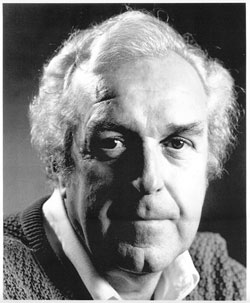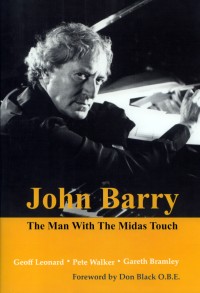Remembering Gene Lees – a Great Supporter of Robert Farnon

Gene Lees, Jazz Critic and Great Supporter of Robert Farnon, has died aged 82
Eugene Frederick John Lees, born on 8 February 1928, in Hamilton, Ontario, the eldest of four children of an expatriate British couple, Harold Lees and the former Dorothy Flatman. He died at his home in Ojai, California on 22 April 2010, After dropping out of the Ontario College of Art, he worked as a newspaper reporter in Canada before moving to Kentucky to become music editor of The Louisville Times in 1955. He was the editor of Downbeat magazine from 1959 to 1961 and went on to write about music for The New York Times and other publications.
Gene Lees was a prolific jazz critic and historian who approached his subject with a journalist’s rigour and an insider’s understanding. The author of numerous books, Gene was not just an observer of the music scene, he was also a participant. The Robert Farnon Society was proud to count him as a valued member for almost fifty years, and he regularly kept in touch with news of his latest assignments.
He was also an accomplished lyricist whose credits included Quiet Nights of Quiet Stars, the English-language lyric for Antonio Carlos Jobim’s Corcovado, which was recorded by Frank Sinatra, Astrud Gilberto and many others. He was also a vocalist, with several albums to his credit.
That experience, and the friendships he built over the years with musicians, singers and songwriters, informed the project that had been his primary focus since 1981: publishing (monthly at first, later at irregular intervals) the subscription-only Gene Lees Jazzletter, mostly as an outlet for his own biographical and historical essays.
"The beauty of this thing," Gene said of his journal in an interview in The New York Times in 1987, "is that it has permitted me to write what I want to write, not what editors want me to write. And the beauty of it for the other contributors is that they’ve got total freedom. No money, but total freedom."
The Jazzletter, published out of his own home, carried no advertising, and its circulation was small, although it included readers whose names any jazz fan would recognize. He initially financed it with income from his book "The Modern Rhyming Dictionary" (Cherry Lane, 1981), and his book and songwriting income helped keep it going. It was reported after his death that his wife of 38 years, the former Janet Suttle, planned to continue publishing it.
Gene was steadfast in his contempt for rock music, calling it "junk" produced by "illiterates."
Mr. Lees supported his strong opinions with strong research. At times that research took him far afield of his ostensible subject. The first chapter of another essay collection, "Singers and the Song" (Oxford, 1987), for example, was a history of the English language from the 10th century to the present.
In addition to seven collections of Jazzletter essays, Mr. Lees’s books include biographies of Woody Herman, Oscar Peterson, Johnny Mercer and the songwriting team Lerner and Loewe. He was also a co-writer of the composer Henry Mancini‘s autobiography and author of two novels. At the time of his death he was working on a biography of Artie Shaw.
Editor: while Gene was editing the US ‘Downbeat’ magazine, in 1961 he published an article on Bob Farnon which caused quite a stir. I make no excuse for repeating it once more, partly for the benefit of newer RFS members, but also to remind us all of the importance of Robert Farnon in the development of decent popular music during the second half of the last century.
Afterthoughts – by Gene Lees
From Downbeat Magazine, 16 February 1961
This issue is more or less devoted to arrangers and composers, particularly Gil Evans.
Evans, you'll note, was born in Toronto, Canada.
Now it happens that Toronto produced another remarkable arranger and composer about the same time, a man named Robert Farnon. Evans left Canada (during his late adolescence) for the United States; Farnon went to England. (Famous two brothers, Dennis and Bryan, came to the U.S. Bryan is now a television music director and Dennis is a well-known west coast arranger.)
If you're a hippie, you've probably never heard of Farnon. He's not the type that the esotericists write about; probably they don't even deign to listen to him. But if your tastes are not insular, and you have any insight at all into the art of orchestration, chances are very good that you're a member of that small group of devotees that I've dubbed the Robert Farnon Irregulars. For they are certainly as zealous a breed as the members of the Baker Street Irregulars, those Arthur Conan Doyle fans who know the Sherlock Holmes novels inside out. Farnon Irregulars are that way about Farnon's charts.
I consider myself one of the ranking members of the group. Dizzy Gillespie, who is another Farnon wig remembers that Bob used to be "a hell of a trumpet player." (Farnon says he gave up trumpet after hearing Gillespie.) But I claim to outrank even Dizzy: when I was a kid, I used to listen to Farnon playing on an otherwise dismal broadcast from Toronto called The Happy Gang. So there, Birks!
André Previn is a Farnon fan, and once said he considered Farnon "the best living string writer." Barney Kessel in turn proudly claims to have introduced Previn to Farnon's music. Oscar Peterson, Ray Brown, and Quincy Jones are Farnon fans. And arranger Marion Evans is not only a Farnon admirer, but has synthesized the Farnon sound better than anyone I've heard. In fact, there is a whole group of New York arrangers who are in love with Farnon's writing, and have been influenced by it. They constitute a special subchapter of the Irregulars, and are known as the Disciples. (They, in turn, refer to Farnon as "the Guv'nor.") I suspect, from listening to his charts, that Nelson Riddle is also a member of the Irregulars.
Chicago bassist Johnny Pate turned out to be a Farnon Irregular. I was very smug about having two Farnon EPs he didn't have - until I found he had three that I didn’t have. We're negotiating.
Al Cohn is a Farnon fan too and Donald Byrd just walked off with two miniature scores of Farnon compositions that I got from the Guv'nor's Own Hand in England a couple of years ago. (Note to Al; hit Byrd for them. Then I WANT THEM BACK!)
Farnon’s reputation in America rests largely on a series of mood music albums he did for English Decca, and some light classical originals, including Canadian Impressions. (Note to other Irregulars; that falling woodwind figure in Lake of the Woods is a simulation of the cry of a loon. And the angular lines in Alcan Highway are meant to be evocative of the Rockies of British Columbia.) All these albums were released in the U.S. by London, with four now available on the subsidiary Richmond label. I urge that you listen to them, particularly Canadian Impressions and Pictures in the Fire.
After you've listened to the "conventional" writing of Farnon for a while, you find that he is an incredibly subtle orchestrator with a rich imagination and superb skill with voicings. There's so much happening in his charts.
For an example, during a passage of fill in the bridge of a pop tone in one of the mood albums, Farnon leaps the orchestra up into another key, then modulates back gracefully to the original key with a lovely figure, leaving you a little breathless; it is as if you had just seen a gust of wind lift autumn leaves, swirl them around in a dancing vortex, and then let them tall gently to earth. And that’s just one bar of fill!
Farnon gave up writing music of that kind a couple of years ago. Having earned a good bit of money doing movie scores for both British and U.S. movies (he also scored a Broadway show, but didn't dig the gig and went back to England), he moved to Guernsey in the Channel Islands and is now writing strictly classical music. Efforts by several jazz musicians to get him to write albums for them has been fruitless - until now.
For in March of this year, Farnon Irregular Gillespie is going to Europe to record the Guv’nor’s nearly-completed Suite for Trumpet and Orchestra, probably with a German symphony orchestra. Farnon is writing it specially for Dizzy. At the same time, Oscar Peterson will record another Farnon work, with Ray Brown and Ed Thigpen integrated into the symphony orchestra. The two works are to be released by Verve on one LP.
Watch for this album. I hope it turns out to be all that Farnon and Peterson and Dizzy want it to be.
Then maybe the Farnon Irregulars will net a batch of new members.
Chords and Discords - Downbeat Magazine, 30 March, 1961
Fair Farnon Fanfare
Add another Farnon fan to your list. I think he is largely responsible for bringing the fresh air of enlightenment to the BBC in London during the late 1940s and early '50s. I thank you for informing me that Bob is appreciated by so many people in jazz. Ridgewood, N. J / Ron Eyre
Funny you should mention Bob Farnon. My girl and I are great English-movie goers, and in many a good picture there seeps through some good jazz band backing. Even the B English pictures have some fine charts. The vast majority have been by Farnon. I'm sorry to say that as a "Farnon Irregular" I've been quite irregular; I haven't a single LP. That will be corrected. Brooklyn, N. Y. / A. J. Smith
Footnote from Gene Lees: It's getting rather hard to be a Farnon Irregular. London Records has never recognized the value of the property they have in the Farnon discs, and they are hard to get. Several have been turned indifferently over to London's secondary line, Richmond, and no attempt has been made to make the public aware of their existence.
Editor: as RFS members will know, the special projects mentioned by Gene (especially with Dizzy Gillespie) never materialized, and happily for us Bob did not turn his back on composing and arranging light music in favour of ‘strictly classical music’.


